Tamil weddings are one of the fascinating and colorful weddings in India . Tamil traditions and customs are extremely dynamic and brimming with life. Tamil Brahmin weddings procedures or rituals lasts up to 3 to 5 days with plenty of traditions with pre-post wedding ceremonies. The best part of the Brahmin wedding is all about the costumes, food and traditional rituals of the wedding. The women are dressed in vibrant silk sarees with blossom or flowers and gold ornaments, whereas men in kurta and dhoti. Getting married in South Indian Brahmin style is so special. That too in best marriage hall in Trichy adds more soul in it.
The wedding celebrations starts with “Pandhakkall Muhurtham” and the rituals ends with “Kattu Sadham”
Let’s take a detailed look about the wedding traditions and rituals of the Tamil Brahmin wedding.
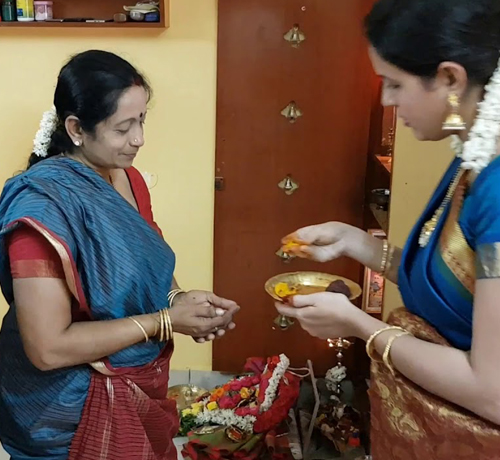
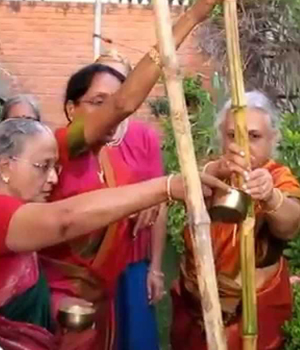
Pandhakkall Muhurtham is performed by bride groom’s and bride’s side women together. These two families visits
temple together or they arrange for a special puja at one of their home. This pooja is observed to pray God so
that wedding should happen without any problems. This ritual is generally performed before the day of wedding.
Panda Kaal Muhurtham is usually done in home and Pandakaal is also placed in marriage hall as well.
Sumangali Prarthanai is special puja which is mainly concentrated for Sumangali or married women who are performing
various rituals of the wedding. These women normally grouped in odd number such as 3 or 5 or 7 gets dressed up in
traditional Madisar saree. Usually women participating in such ritual are close relative and family friends. This is
not done in marriage hall. After completing the Pooja, Bride gets blessings from all the sumangali and they give
gifts to the bride.
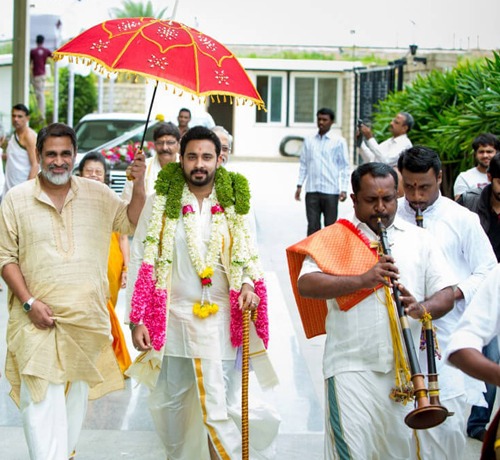
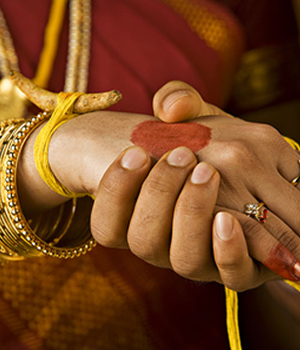
The bride’s family welcomes the groom’s family at the marriage hall performing
aarathi ceremony and a plate full of nuts, sweets, fruits, flowers and clothes. Either brother or sister
of bride applies thilakam on the grrom forehead and gets cash or jewelry gift from the groom as a return gift
for welcoming the groom.
Viratham is observed at the groom’s home around early morning before the day of the
wedding in marriage hall. This is one of the most important day for the groom since it is the day that
represents the transition of the groom from the Bramachary stage of life to Garhasthaya stage of life.
He gets permission from his father to proceed this stage. A yellow colored thread with turmeric is tied around
the groom’s wrists. Similar ceremony happens to bride at the same time. The same yellow colored thread with
turmeric is tied around the bride’s wrists too. This thread is tied to protect both bride and groom from the
evil energy.
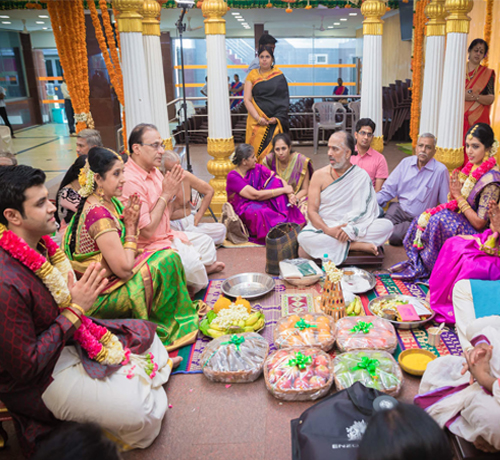
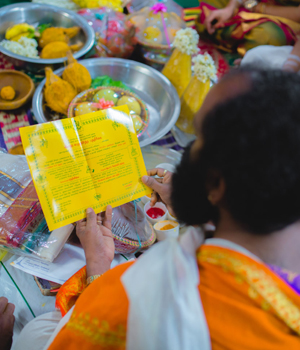
Nichayathartham is a formal engagement function if it is a Tamil wedding.
This ritual starts with Pooja to Lord Vinayagar at marriage hall or at bride’s home. Groom’s family gifts bride
with splendid saree and jewelry and Bride’s family gifts groom with elegant men’s wear. Both Bride and the groom
then change their new dresses. The couple can exchange the rings at the end of the ceremony.
Lagna pathrikkai procedure generally involves wedding announcement and verbal
invitation. The family priests after reviewing the couple horoscopes they decide the wedding date of the couples
which is formally drafted in Lagna pathrikkai. It clearly says Bride, Groom and family member names, marriage date
and the exact marriage time. After writing this it is announced in front of all the members gathered. After that head
of the family from each side reviews and signs on the Lagna pathrikkai. This ritual may be performed at marriage hall
or at the one of the couple home.
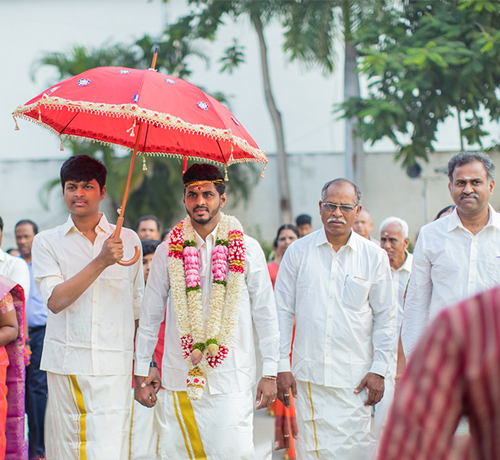
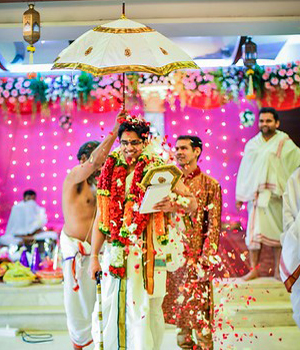
On the morning of wedding day at marriage hall, both bride and groom takes mangala snanam which means holi bath and then get ready for the match day. The old tradition says that groom has to pretend himself that he is leaving to kashi for mangal yatra to become sanyasi which means a monk. But, the bride’s father holds groom’s hand and convinces him not to go to sanyasam and marry his daughter. After getting convinced the groom decides to marry and starts to the marriage hall in Trichy where the bride’s family welcomes him.
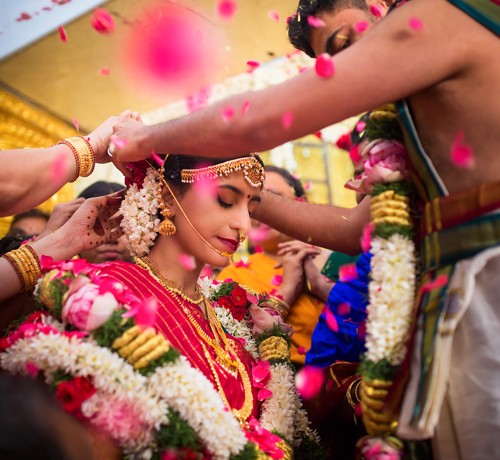
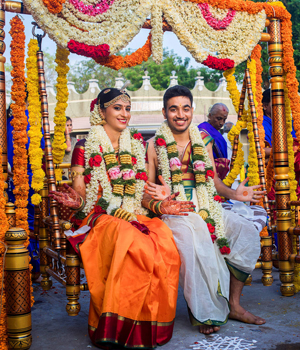
Oonjal is nothing but a swing. The bride and the groom made to sit on the
wooden big plank swing and rocked gently. Where the family ladies sings traditional folk songs which says the
holiness and traditional values of marriage. The family member one by one offers the groom and the bride with
milk and banana. This is usually performed at the marriage hall to reduce stress about the marriage and make
the couple tension free and happily enjoy the marriage.
Kanyadanam is a ritual, both bride and groom step inside the marriage hall
together to start the marriage. The groom feet is washed by the bride’s father and the kajal is appied in the
groom’s eyes as well by the bride’s mother as ritual. During the muhurtham, bride’s hand is held by her father
and handed over to the groom means kanyadanam.
After the kanyadanam ritual, the bride is gifted with a nine yard
saree from groom’s family. Bride is supposed to change her nine yard-Madisar Saree. After changing the new saree,
bride and groom holds the hand. The groom ties Mangayam (Thali) knot three times while the bride folds her hand.
The Muhurtham ends after tying three knots. After that couple seeks blessings and wishes from friends and family
gathered in marriage hall.
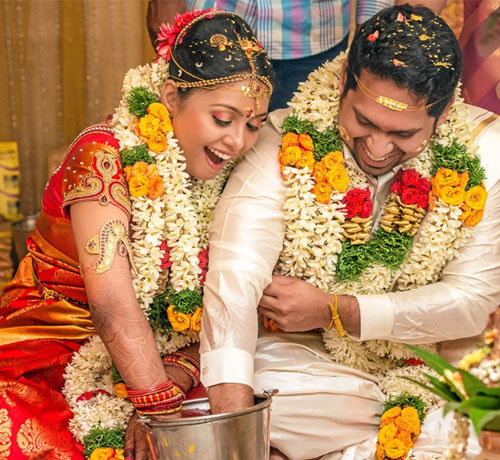
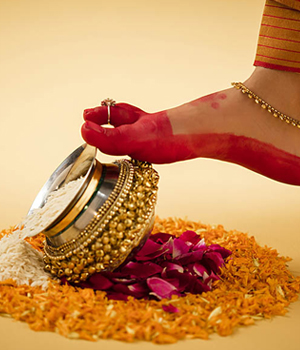
The marriage is continued with a formal reception in the evening at the same marriage
hall where all the family member and friends are treated with a delicious vegetarian dishes. The newly wedded couples
are seated on big stylish chairs on top of the stage, where couples can meet and greet and get wishes from all the guests.
Once the bride reaches the groom’s home, brides’s mother-in-law performs small aarathi
ritual and gives her a warm welcome. Then takes her inside the home and bride seeks the blessings of the family
deity first.
In Nalungu celebrations, plenty of the games are played after the wedding to create an emotional
bond between the bride and the groom.
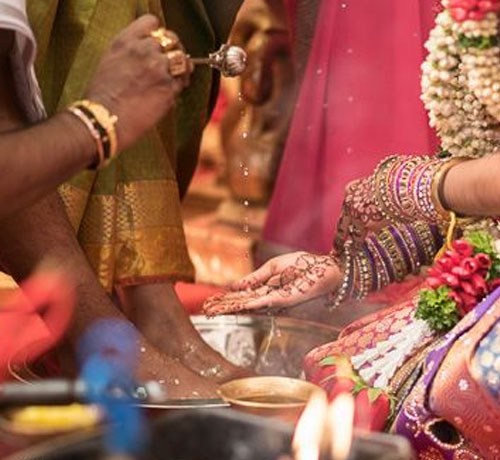
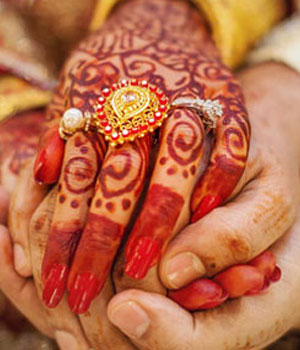
For Sammandhi Maryathai the two families exchange gifts between them and the bride gets prepared to leave her paternal home.
It is a bit emotional and sentimental goodbye from her parents and relatives.
Paaladaanam means that before starting to the groom’s home, the bride and the groom touches the feets and gets
the blessings from the elders. Then the groom takes the bride to his home from the marriage hall.
Finally, as per our old traditions brides’s family packs kattu sadham to groom's family and send off's the bride
to the groom's home.
Contact us now and we will make your event unique & unforgettable